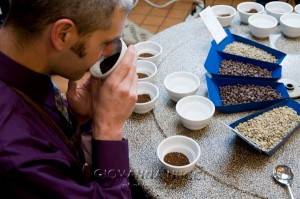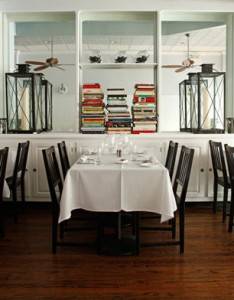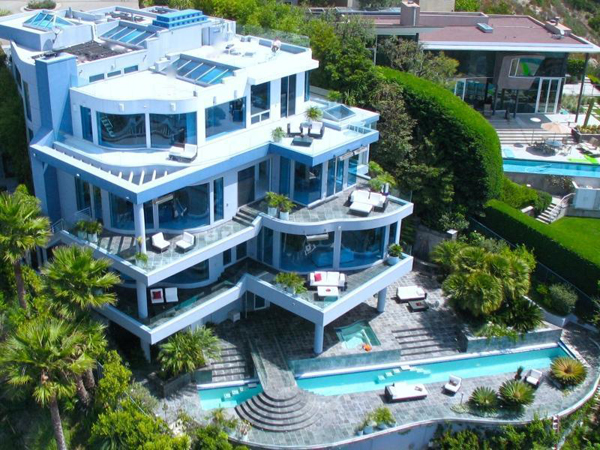
Coffee…it’s an obsession with New Yorkers.
We seek out coffee shops in search of the next best cup, and we marvel at outrageous espresso machines (like the $18,000 slayer at RBC NYC in Tribeca) or on-site coffee roasters (housed at The Roasting Plant) — whatever it takes to keep our senses amused and our adrenalin high. And if there’s anyone who’s on board with our penchant for a spectacular coffee experience, it’s John Moore. Moore, the vice president of Dallis Coffee in Queens, is one of the rare few Q Graders, i.e. top-tier coffee experts in the world. His knowledge of coffee, from agriculture through roasting and tasting, is encyclopedic. He is trained to detect more than 300 different aromatics in any cup of coffee — blindfolded! — in order to properly grade the coffees, detect defects and profile beans for different roasting qualities.
Moore travels the world finding the best coffee and dealing with top farmers — he recently returned from Rwanda after trips to South America and competitions in London. Here, this coffee genius shares his insights with us.
Haute Living: When led you to become a Q-grader?
John Moore: It was in April of 2008, and funny enough I ended up taking the Q Grader exam as somewhat of an accident. At the time a colleague had to drop out with no notice and I was picked as a replacement. I was told that I was going to a coffee laboratory in Vermont for a week of training. Imagine my surprise when I arrived the first moment and the instructor told me to get my score sheet and prepare for the first exam!
I certainly look back on this now as a serendipitous twist of fate since I enjoyed the testing process, working with the other people in the group, and joining the ranks of Q Graders all over the country and around the world. The Q system provides a platform for coffee professionals to communicate about the qualities of a given coffee using a common language.
HL: How long was the process?
JM: The process involves about 4 ½ to 5 days of testing, and as with many culinary accreditation programs consists of both sensory and written examinations. 22 sensory tests in all are on the agenda. I’ll send an example of an exam itinerary so that you can get a sense of what is included, but if any single test is not passed the Q grade certification is not awarded.
HL: What do you love about coffee?
JM: That is a great question. How many pages do I have to answer? I love many things about coffee. I love the rich history; the philosophical musings often coffee inspired; the cultural exchanges and first hand experiences of the world that coffee has graced upon me; the way that coffee bars or cafes often serve as community hubs or the community “third places;” the fact that coffee can serve as a vehicle for sustainable development in places striving to achieve a better quality of life; the way that coffee affects me physically; and most of all, the complexity and beauty of great cup.
HL: What are some of your favorite New York City coffee shops?
JM: I find myself drawn to the coffee shops that were driving the local community forward when I was more directly hitting the streets a few years ago. I think that a number of entrepreneurs have done an amazing job here in New York City — Café Grumpy, Third Rail, Ninth Street Espresso, Gimme! Coffee, Abraço, Oslo and Joe & the Art of Coffee all come to mind. Of the newer additions Ost Café, Karloff, and Stumptown are great spots. I’ve heard great things about Blue Bottle in Brooklyn but have yet to get by there myself. For nostalgia’s sake every now and then I’ll wander into Caffe Reggio just to ogle the beautiful old espresso machine in the back of the room.
HL: What do you see as some of the current trends in coffee?
JM: There is a great deal going on in the world of coffee right now. I see a greater focus on quality coffee programs in some of America’s largest mainstream food operations — McDonald’s, Dunkin’, Starbucks and a host of other massive companies are competing for our breakfast dollars through their more significant than ever coffee and espresso based beverage programs.
Smaller, independent operators are able to differentiate from these more commercial coffee operators by focusing on their coffee quality, cutting-edge preparation techniques and passion. Because the larger players have provided familiarity with a huge audience independents are able to thrive off a niche of this new consumer pool. The rising tide carries all boats, and the tide continues to crest higher and higher as independents push for greater transparency, sustainability, supply chain integration, technological advancements and ultimately a better quality coffee.
Specific trends are focused on the notions of treating coffee with a new-found respect and positioning it rightfully as having cracked into the culinary community. Concepts such as seasonality in coffee, brewing fresh per customer, working with certified sustainable programs, working with programs such as Cup of Excellence to ensure transparency and quality, and working to educate end users in the diversity of flavor profiles available more than ever through public cuppings or tasting all seem to be prominent current trends.
HL: Where do you like to dine out in New York City?
JM: It really depends on what sort of meal I am looking to enjoy. Savoy, Gramercy Tavern, Union Square Café and City Hall are all iconic local institutions that never cease to impress. Even after leaving Brooklyn I always look forward to a delicious meal at Franny’s. Now that I’m in Queens I enjoy winding down a day with a meal at Jackson Diner.
HL: What is your favorite New York City neighborhood?
JM: For me this is a bit like asking which is my favorite type of coffee. I like different coffees at different times of day or brewed using different techniques depending very much on my mood or mindset. I love New York City, and I’ve lived or worked in just about every borough. The coziness of Park Slope, the edge of the East Village, the culture of the West Village, the hustle of Downtown, the buzz around Yankee Stadium, and so forth. To me the beauty of New York City is that it remains a collection of over a thousand small villages, each with a unique culture of its own to be discovered and explored.
HL: What do you like to do on your days off?
JM: I enjoy spending time with my family either exploring local neighborhoods or hiking around trails in the surrounding area. Trips to the local pools, gyms, or parks keep me very busy and on my toes when not at work.
HL: Your favorite vacation destination?
JM: I enjoy visiting my mother and sister who live in Charleston, S.C. Family, beaches, swamps and food culture that readily embraces butter, bacon and fat — great stuff.
HL: What’s your most memorable meal?
JM: I would have to say that a recent trip to Rwanda provided one of the most memorable meals I have had in quite some time. The day after the Cup of Excellence Awards Ceremony announced the winning farms a few jury members trekked out to visit the farm and mill that produced this past year’s top coffee. The caveat — the winning farm was on Gishamwana Island in the middle of Lake Kivu, one of Africa’s great lakes that serves as a border between Rwanda and the Democratic Republic of Congo.
Although it was a bit tricky finding a boat to make the trip initially, we finally found a small craft available at the Hotel Malahide Paradis, which also ended up our dinner spot for the evening once we returned.
Imagine a coffee person visiting an island full of coffee plants that were considered the finest in the country, then traveling via boat to the mill that seemed to emerge from a primordial mist, and finally returning to a beautiful shoreline hotel for a meal.
Although all of this would make it one of the more memorable meals for quite some time, the fact that there was no power at all in the facility made for an amazing experience. Water for washing hands was in ceramic urns and a small open fire adjacent to our meal kept the bugs at bay. The most moving and remarkable element of the evening was the fact that the local fishermen were singing on their way out to the night’s catch — magic.
HL: What are some of your favorite coffee aromas?
JM: Some of my favorites include coffee blossom, fresh ginger, papaya, marzipan, tangerine, blackberry, lemon, cinnamon, curry and molasses.
HL: How do you drink your coffee?
JM: I drink my coffee black.
HL: Do you have a favorite blend?
JM: In all honesty I tend to focus more attention on single origin coffees than I do on blends because there is something beautiful in their inherently temporary nature. Although many within the coffee industry have been shouting it from the rooftops, many people outside of the bubble have yet to see coffee as they might wine or other agricultural products — as unique from crop cycle to crop cycle.
Having said that, it is a great challenge to create the consistency required of a blend when the goal is to keep a flavor profile consistent despite seasonally shifting component ingredients. At the moment my favorite is a new proprietary blend that we crafted for Jonathan Benno, Paolo Novello, and the team at the new Lincoln restaurant in Lincoln Center.
To contact Tracey Ceurvels, visit her blog, The Busy Hedonist, or email her.




















